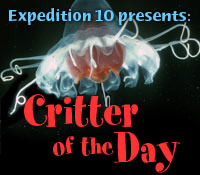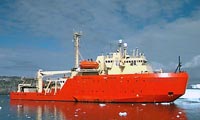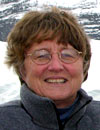|
  Today's Weather Mostly sunny Sky color, blue, with few clouds Lat: 64.46.48 S Long: 64.03.31 W Wind: 5 K Sea State: 1 Swell Height: calm Baro Pressure: 977.4 MB Air Temp: 3.0 Sea Surface Temp: 2.5 Vis: 6 NM    Learn about the L.M. Gould in Deeper Discovery» on the L. M. Gould February 21, 2006 by Kate Madin The drawers and cabinets in the ship’s four labs are filled, and everyone on the team has a place to work. The equipment is stowed and secured against rough seas. The ship has steamed for four days straight, from Punta Arenas, Chile to Palmer Station—the smallest of three United States research bases in Antarctica—for an overnight stay, and the real research will soon begin. The moment the ship leaves Palmer Station, we will be on our own. At sea, whatever you brought with you is all you have. For 16 scientists spending three weeks at sea near Antarctica, this brief stop is the last chance to look for any lab supplies forgotten in the rush of packing. The effort everyone put into packing and shipping their materials and gear, two months ago, has to pay off now. We will be studying salps The scientists are anxious to start—so anxious that they have already looked for salps on the way across to Palmer Station! “Salps are important players in ocean ecosystems, whose basic biology is not well understood,” said Larry. “And with climate change,” said Pat, “the Southern Ocean food web could change, with salps instead of krill, and major effects on animals that eat krill, such as penguins.” “A research cruise to the Southern Ocean is a rare opportunity,” said biologist Larry Madin, chief scientist on the cruise. “We are lucky to be here with a team of specialists, all studying one thing—salps, instead of dividing the ship’s schedule among groups studying many different things.” A lot happens during the single day at Palmer. The Gould’s crew unloads supplies for the station, and carefully lowers the group’s dive van—a portable room for storing dive gear—into the ship’s hold with the crane. Erich Horgan gathers team members to unpack, assemble, and secure two special collecting nets the team uses to collect plankton at many depths. It even has a name, MOCNESS, for Multiple Opening and Closing Net Environmental Sensing Systems (more about this in a later journal). The scuba divers unpack and arrange their gear in the van, ready to go. Biological oceanographer Pat Kremer borrows extra forceps from the Palmer Station lab to add to those she brought. And everyone marvels at a three-hour sunset display. The next day, the ship departs at 10 a.m., and Palmer Station recedes astern. The science team will be supported by the ship’s 14 crew, and six technicians who operate and maintain equipment. Everyone has a specialty, and all are needed to make the cruise a success. Interview
|
|||||||||||||||||||||||||||||||||||||||||||||||||||||||||||||||||||||||||||||||||||||||||||||
Mailing List | Feedback | Glossary | For Teachers | About Us | Contact
© 2010 Dive and Discover™. Dive and Discover™ is a registered trademark of Woods
Hole Oceanographic Institution

